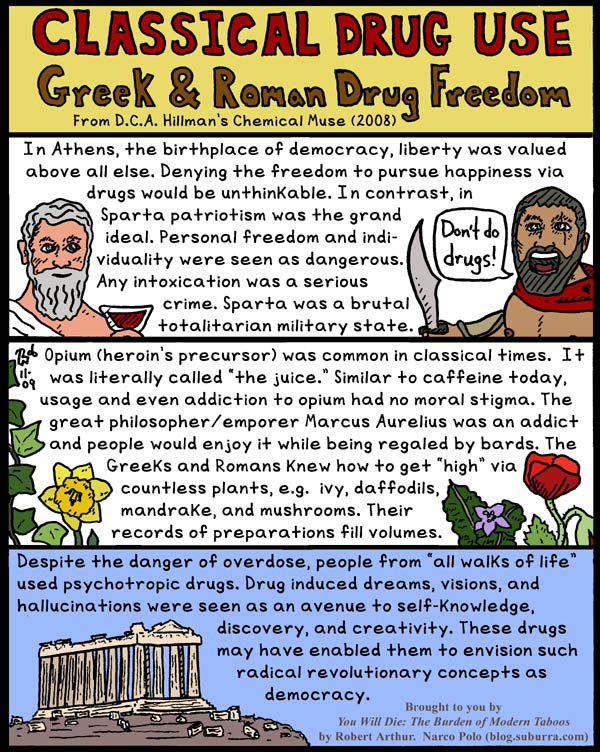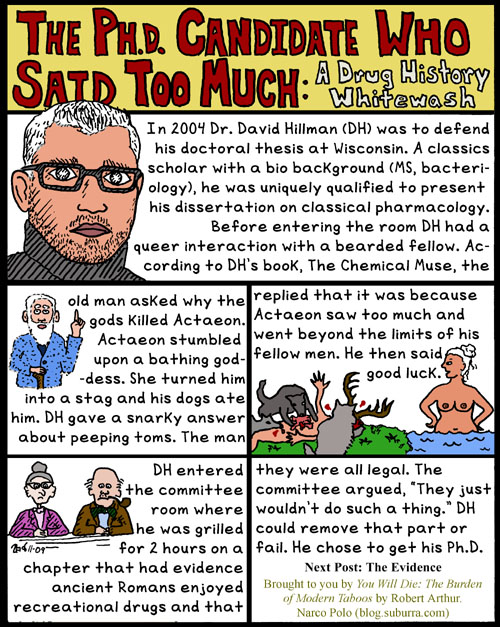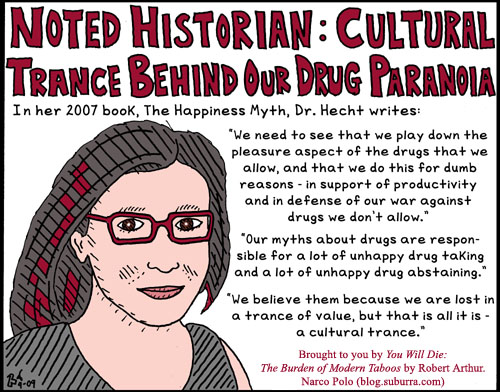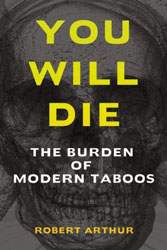Posted: November 16th, 2009 | Filed under: alcohol, drugs, hallucinogens, heroin, history, legalization, mushrooms, opiates | 12 Comments »

As Dr. David Hillman writes in his book, The Chemical Muse (2008):
The Greeks and Romans used opium, anticholinergics, and numerous botanical toxins to induce states of mental euphoria, create hallucinations, and alter their own consciousness; this is an indisputable fact. (p. 87)
This fact has been intentionally ignored and covered up by historians. (See previous post.) Recreational drugs have been translated out of classical literature in the same manner as bawdy sexual references were until recent decades.
This has occurred with individual words. Opium has been translated into poppy seeds even where it makes no sense. But it has also occurred with entire concepts.
Drugs, Sex, Magic
Classical literature abounds with sorcerers, magicians, and witches. Translators rarely reveal that their power stemmed from their great expertise in drugs. Sorcerers were classical drug dealers and the effects of drugs were seen as magical in those times. Drugs and magic were one.
Medea, the wife of Jason the Argonaut, is frequently portrayed as a witch. She aided Jason by putting fire-breathing bulls asleep and giving him amazing courage. Hillman shows how translators mistranslate polypharmakon and pharmaka to present her as being skilled in the “magical arts” and a possessor of “charms.” Medea was actually “drug-savvy” and possessed “drugs.” She gave the bulls and Jason drugs, not spells.
Sorcerers were honored and respected members of society. They and the more run-of-the-mill drug sellers, “root cutters,” had to know how to extract desired chemicals from plants and animals. This was an exact science for the wrong amount or the wrong extraction could kill. For example, mandrake in minute doses could generate euphoria and stimulate libido, at low doses it was an anesthetic, and at regular doses it was lethal.
Symposia and Spiked Wine
The Greeks and Romans favored method of drug administration was to mix them with wine. This has allowed history teachers to present ancient revelers as merely drinkers – not “illegal drug” users. As the scholar, Dr. Carl A.P. Ruck has written:
Ancient wine, like the wine of most early peoples, did not contain alcohol as its sole inebrient but was ordinarily a variable infusion of herbal toxins in a vinous liquid. Unguents, spices, and herbs, all with recognized psychotropic properties, could be added to the wine. (pp. 176-177)
This gives an entirely different purview of the Greek symposia. At these “riotous drinking parties” great minds like Socrates and Plato debated and developed their theories on the great philosophical questions. Another clue tells even more. Altered states of consciousness were viewed as divinely provided madness. Plato wrote:
But he who without divine madness comes to the doors of the Muses, confident that he will be a good poet by art, meets with no success, and the poetry of the sane man vanishes into nothingness before that of the inspired madmen. (p. 177)
To learn about the academic censorship of this scholarship read, “The Ph.D. Candidate Who Said Too Much: A Drug History Whitewash.”
Source:
D.C.A. Hillman, The Chemical Muse: Drug Use and the Roots of Western Civilization (2008). LINK
Posted: November 11th, 2009 | Filed under: drugs, history, legalization | 4 Comments »

The chapter rejected by Dr. David Hillman’s doctoral committee eventually became the basis of his book, The Chemical Muse (2008).
As he writes in its introduction:
I wanted the modern West to see that its founding fathers were drug users, plain and simple; they grew the stuff, they sold the stuff, and, most important, they used the stuff. The modern antidrug campaign is not a democratic movement at all; the ancient world didn’t have a Nancy Reagan, it didn’t wage a billion-dollar drug war, it didn’t imprison people who used drugs, and it didn’t embrace sobriety as a virtue. It indulged … and from this world in which drugs were a universally accepted part of life sprang art, literature, science, and philosophy. (Hillman, p. 3)
On his doctoral experience:
Unfortunately, the moral bent that so characterizes contemporary Classicists forces them to write histories that best promote the cultural agendas of our times, rather than the actual facts of the past …. Blacklisting is not a cruelty of the distant, uninformed past; it’s a very real phenomenon that flourishes within academic circles today, whether in the humanities or the sciences. (Hillman, p. 222)
Hillman is not alone. The classicist, Dr. Carl A.P. Ruck, contributed to the book, The Road to Eleusis (1978), that explored the Athenians use of a natural version of LSD in a sacred ceremony. (A co-contributor was Albert Hofmann.) Ruck’s scholarship in this area, which has been published in a peer reviewed journal, is not challenged but simply ignored. Ruck has said about the stigma of his work:
One anonymous reader, before the book finally found a publisher complained that “the author had had a good education at the best schools,” but that somehow I’d gone wrong …. Students who work with me have been warned that they will be blacklisted. My textbooks in grammar, as well, as if by contagion, are viewed by some as suspect and a threat to normalcy. (Hillman, p. 209)
Link of Note: A 2008 article on Hillman in the Madison, Wisconsin weekly, Isthmus, that includes his doctoral committee’s response. LINK
Next Post: A peek at some of the evidence of classical drug use found in Hillman’s book. LINK
Sources:
1. D.C.A. Hillman, The Chemical Muse: Drug Use and the Roots of Western Civilization (2008). LINK
2. Kevin Revolinski, “Everybody Musta Got Stoned,” Isthmus, 31 Oct. 2008. LINK
Posted: September 16th, 2009 | Filed under: cocaine, drugs, history, marijuana, opiates | 2 Comments »

In her popular 2007 book, The Happiness Myth: Why What We Think Is Wrong, historian Jennifer Michael Hecht calls our current demonization of drugs a “cultural trance.” (p. 71) Just like past irrational attitudes the modern view of drugs may eventually reveal itself as, “bossy, shaming, controlling nonsense.” (p. 2)
People follow the conventional wisdom of their era in pursuing happiness. Hecht points out that experts have been proven wrong throughout history and that there is no reason to believe the current batch will fare any better. She reveals numerous “nonsensical cultural assumptions” about drugs, the primary one being that drug induced happiness is inferior to sober happiness. (p. 7)
It wasn’t until the early 20th century that pleasure via drugs was characterized as “naughty.” All cultures have had favorite chemicals to feel better. (The Bible repeatedly advocates using alcohol for joy.) This history has been whitewashed in America. For example, few know that marijuana has been smoked from braziers in Europe since the onset of agriculture roughly 5,000 years ago or that the French Renaissance literary character, the giant Pantagruel, was named after marijuana and smoked it constantly.
Hecht dares to point out that even addiction can be pleasurable. Much of America is addicted to caffeine and looks forward to their “boosts.” They do not suffer because caffeine is freely available. In other cultures and times opiates and cocaine were used in a similarly benign fashion, i.e. laudanum in the West and coca chewing in South America.
Hecht explains how easily our drug attitudes could have been formed differently and how arbitrary our drug categories are. If coca leaves transported easier, chewing may have caught on in Europe and there may have been more resistance to the cocaine prohibitionists. Likewise if caffeine is “chemically goosed” to provide an intense high, caffeine might become a target of the drug war. (p. 92)
In Native American culture there were periodic festivals involving dancing and the closely supervised administration of drugs which brought about spiritual revelation and euphoria. Teenagers participated. A longing for these experiences still exists as, “many people, especially young people, say they are never happier than when they are a little high and listening to live music, or dancing.” (p. 118) However, in current American culture this behavior has been criminalized due to our “pharmacological Calvinism” so young adults who persist must get their substances from the black market and consume them without supervision. (p. 119)
Hecht lists circumstances in which she suggests one consider using drugs. Some of them are:
1. If you long for a break from your “symptoms” or merely from your personality.
2. If you want to know more about the nature of reality and how the mind creates it.
3. If you want to have an intense communing experience with someone.
4. If you want to have a good time on a given evening.
5. If you want to dance and be social, but you are too inhibited.
Hecht cautions people against using illegal drugs in the current environment and recognizes their dangers. However, she writes that life is full of risky behaviors, e.g. driving cars, mountain climbing, living a sedentary life. The risks and benefits are balanced when deciding whether to regulate or criminalize these activities, but with drugs modern policy makers completely discount the happiness that drugs bring.
Modern pundits who claim we are dosing ourselves too freely are not speaking with historical knowledge or philosophical sense. Keeping your mind in only one place is not a very assertive way to relate to life, to search it for happiness, or for truth. (p. 127)
The Happiness Myth: Why What We Think Is Wrong also covers false cultural assumptions in the areas of wisdom, money, bodies, and celebration.





